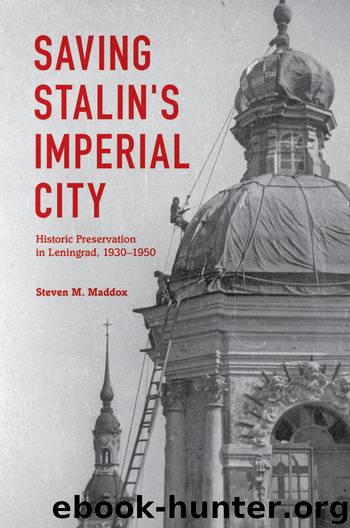Saving Stalin's Imperial City by Maddox Steven M

Author:Maddox, Steven M.
Language: eng
Format: epub
Publisher: Indiana University Press
Oktiabrskii
140
185
7,400
Frunzenskii
83
124
4,960
Dzerzhinskii
102
120
4,800
Kuibyshevskii
90
112
4,480
Petrogradskii
73
108
4,320
Nevskii
59
107
4,280
Vyborgskii
69
92
3,680
Moskovskii
75
88
3,520
Kirovskii
63
83
3,400
Vasileoostrvoskii
55
82
3,280
Kalininskii
54
75
3,000
Leninskii
59
69
2,760
Zhdanovskii
61
66
2,640
Smol’ninskii
50
65
2,600
Sverdlovskii
38
59
2,360
Totals
1,071
1,437
57,480
Source: TsGAIPD SPb, f. 25, op. 18, d. 92, l. 13.
The city party committee played an influential role in promoting attendance at the museum, and thereby a more widespread dissemination of the blockade narrative. City officials understood that the blockade’s message of sacrifice for the city could best be inculcated in migrants, and Leningraders themselves, through attendance at the museum. In light of this, party activists organized group excursions from most, if not all, of the city’s places of work. Official party publications, such as Bloknot agitatora and the Leningrad press, summoned activists to make wide use of the exhibition and museum, noting that it offered the “richest” of materials for both “working on oneself in preparing for talks” and “mass agitational work among the laborers of Leningrad.”105 Such calls were well received by activists throughout the city, who saw an opportunity to expose people who had not lived through the war in Leningrad to the realities of the city’s experience. At times when it was felt that museum attendance had declined in certain districts, both the museum and the Department of Agitation and Propaganda pushed for more work to be carried out by activists in those districts. The parties involved noticed a higher number of people attending the museum from areas in which activist work on the blockade was carried out daily.106 Indeed, activists played an important role in organizing excursions to the museum from the city’s factories, plants, and institutes. According to party activists’ reports, these excursions made “great impressions” on people and provided a “new flood of strength” among workers.107
Throughout the early postwar period – until mid-1949 – the Museum of the Defense of Leningrad was the second-most-popular museum in the city, behind only the State Hermitage. By May 1949, five years after it opened, 1,565,300 people had visited the exhibition and the museum, a truly astounding number given that the museum had been closed for certain periods of time to allow for the reconstruction of halls and exhibits.108 Although the attendance record was impressive, it must be noted that it involved a certain element of coercion; organized excursions were often mandatory, meaning that people could receive reprimands at their places of work if they did not attend the museum with their coworkers. The party leadership wanted to see museum attendance increase to ensure that the state-sponsored memory of the blockade – which promoted a narrative of Leningrad exceptionalism and silenced issues that ran counter to the heroic myth of the war – would become a central part of people’s lives in the postwar period. The museum thus evolved into a place of pilgrimage, learning, and propaganda that could be visited year round.
Download
This site does not store any files on its server. We only index and link to content provided by other sites. Please contact the content providers to delete copyright contents if any and email us, we'll remove relevant links or contents immediately.
| Anthropology | Archaeology |
| Philosophy | Politics & Government |
| Social Sciences | Sociology |
| Women's Studies |
Cecilia; Or, Memoirs of an Heiress — Volume 1 by Fanny Burney(32435)
Cecilia; Or, Memoirs of an Heiress — Volume 2 by Fanny Burney(31871)
Cecilia; Or, Memoirs of an Heiress — Volume 3 by Fanny Burney(31856)
The Great Music City by Andrea Baker(31359)
We're Going to Need More Wine by Gabrielle Union(18969)
All the Missing Girls by Megan Miranda(15579)
Pimp by Iceberg Slim(14395)
Bombshells: Glamour Girls of a Lifetime by Sullivan Steve(13976)
Talking to Strangers by Malcolm Gladwell(13222)
Norse Mythology by Gaiman Neil(13208)
Fifty Shades Freed by E L James(13157)
For the Love of Europe by Rick Steves(13024)
Mindhunter: Inside the FBI's Elite Serial Crime Unit by John E. Douglas & Mark Olshaker(9201)
Crazy Rich Asians by Kevin Kwan(9168)
The Lost Art of Listening by Michael P. Nichols(7408)
Enlightenment Now: The Case for Reason, Science, Humanism, and Progress by Steven Pinker(7237)
The Four Agreements by Don Miguel Ruiz(6634)
Bad Blood by John Carreyrou(6552)
Weapons of Math Destruction by Cathy O'Neil(6146)
